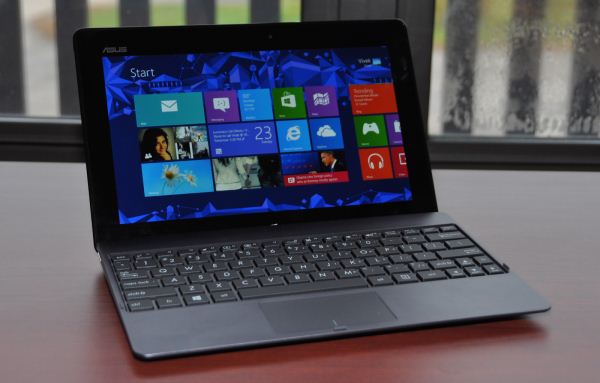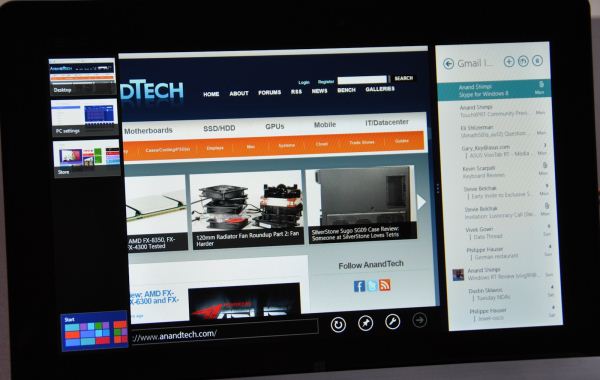The Windows RT Review
by Vivek Gowri & Anand Lal Shimpi on October 25, 2012 12:00 PM EST- Posted in
- Windows RT
- Operating Systems
- Microsoft
- Mobile
- Windows 8
- Tablets
Final Words
So, ten thousand words later, what can we take away from Windows RT? It’s definitely another superb user experience design from Microsoft. Say what you will about Windows Phone 7, but damn if that UI isn’t gorgeous. The Metro design language translates over to the tablet form factor really well, resulting in the Windows Modern UI. We’ve obviously known how Modern UI looks and feels through the various Windows 8 preview builds, but Windows RT ends up being more focused and offering a more consistent experience. It’s a side effect of being limited to apps from the Windows Store - because you spend a significant majority of your time in the new Windows UI, desktop use is minimized. In Windows RT, the Windows Desktop serves the purpose of being the more capable and powerful layer underneath the main portion of the UI, as opposed to Windows 8, which sometimes feels like the new Windows UI existing as an impractical interface layer on top of the traditional desktop.
The dichotomy just feels more comfortable in Windows RT than I feel like it has been in the previous Windows 8 systems that I’ve dealt with. It’s nice. This is the first time I feel like I’ve really connected with the new Windows UI, it makes a ton of sense to me now. I still think for mouse-based navigation, you’re better off treating it as a glorified Start menu, but it’ll be interesting to see how legacy programs affect the use of Modern UI in x86-based Windows 8 tablets as the Windows Store matures.
If you’re really concerned about the state of third-party apps, you just have to wait and see. I’ve seen a lot of snap judgements made about Windows RT in the last couple of days based on the dearth of good applications in Windows Store, and while I agree with that sentiment, I feel like it’s extremely shortsighted to write off the ecosystem already. Neither version of the OS has gone on sale yet, and we know that there are a number of applications that will go live on the official release date, as well as many more coming in the weeks ahead.
This isn’t like Windows Phone, where we need to see whether the platform will get any market traction before predicting the growth of the app marketplace. You can basically assume that the marketplace will expand significantly unless somehow everyone stops buying Windows-based systems on October 26th. The odds of that situation arising seem relatively low, so my bet is that the strength of the ecosystem will be a non-issue a month from now.
The default inclusion of Office 2013 and the emphasis on physical keyboards makes Windows RT the first tablet platform to significantly address the question of productivity. Combined with the equally advanced task switching and multitasking built into the UI, and this becomes the first legitimately useful tablet operating system out there. The Galaxy Note 10.1 wasn’t bad, but it was a single device that built additional functionality into a custom Android skin. Every single Windows RT slate comes out of the box with Office and the ability to have multiple active application windows. It’s just a few steps ahead of competing tablet platforms at this point.
And it’s not like RT loses out on a content consumption front. It’s paired with what is a very strong entertainment store and gaming franchise in Xbox Live, and the browsing experience is definitely competitive. It’s also a competent e-reader, with Amazon’s Kindle being one of the headlining apps currently in Windows Store. It even matches the power efficiency of the other ARM-based tablets, with competitive battery life and standby time. Obviously, ARM is the driving factor in the low power consumption, but it’s good to see that Windows is on a similar level as iOS and Android.
So this is a tablet platform that can do a good job of replacing both an iPad and an ultraportable in a number of different workflows. You get the best of both worlds, in some sense - Windows RT tablets have similar form factors to the iPad and leading Android tablets, and offer near-equal battery life, performance, and user experience, but they also give you the added benefit of strong productivity applications and the power of Windows Desktop. From a conceptual standpoint, almost anything you can do with an iPad can be done equally well (or close) on a Windows RT tablet, but the desktop-caliber office suite and versatile multitasking interface of Windows RT are impossible experiences to replicate on the iPad. It's not a perfect operating system by any means, but it brings a new dimension to the tablet space. So if you’re looking for a new tablet this fall, Windows RT deserves your consideration.













233 Comments
View All Comments
steven75 - Friday, November 2, 2012 - link
Huge problem. Windows 8 x86 != Windows RT compatible version.There's basically no reason to make Metro apps if you already have a working x86 app unless RT is some kind of phenomenon.
Oxford Guy - Thursday, October 25, 2012 - link
horrifyinghttp://images.anandtech.com/doci/6392/Music-Sideba...
http://images.anandtech.com/doci/6392/Screenshot%2...
http://images.anandtech.com/doci/6392/Charms.png
bad
http://images.anandtech.com/doci/6392/TaskSwitcher...
Sharp edges everywhere. Playskool colors without the roundness that makes Playskool stuff far less wretched. Misdirection aplenty.
No way. Sticking with iOS.
Oxford Guy - Thursday, October 25, 2012 - link
I think that third pic should be called the schizophrenia design language.kyuu - Thursday, October 25, 2012 - link
... Are you talking about the *background*? You're seriously going to leverage a complaint about the OS based on the *background image*?Wow.
Oxford Guy - Thursday, October 25, 2012 - link
I am not just talking about the background.kyuu - Thursday, October 25, 2012 - link
Lol.Aesthetics are, of course, completely subjective, but complaining about Metro/Modern-UI while sticking with the chiclets-on-a-grid iOS just seems silly to me.
Oxford Guy - Thursday, October 25, 2012 - link
Aesthetics is not an area that is anywhere near being completely subjective. For instance, eye tracking research has found that men look at crotches and women don't. There is a lot of psychology involved in designing an attractive and usable interface. Unfortunately, a lot of designers think aesthetics is a more subjective field than it is. Many think, erroneously, that what works well on paper works well on the screen, too.Those photos present clutter, disorder, sharp edges, and other unpleasant design attributes. The giant sharp-edged colored box look that's so prevalent is jarring, unpleasant, and unfortunate.
iOS's chiclets, at least, have softer more humanized edges and adequate space between. The soft rippled background on my iPhone 5 is also more humane than the schizoid gizmo look.
If you think aesthetics is totally subjective, explain why Microsoft Bob didn't succeed. Why don't all our computers look like THAT?
ludikraut - Friday, October 26, 2012 - link
I guess that must make me a schizo then, since I disagree with all of your points.l8r)
Dorek - Friday, November 2, 2012 - link
What, are you worried you'll cut yourself?Devo2007 - Thursday, October 25, 2012 - link
"Swipe in from the left and you flip through apps, giving Microsoft the win for quickest task switcher among all tablets"While it's not iOS or Android, the BlackBerry PlayBook can swipe through apps by swiping in from the left or right. So in this case, I'd call it a tie.